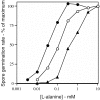Cooperativity between different nutrient receptors in germination of spores of Bacillus subtilis and reduction of this cooperativity by alterations in the GerB receptor
- PMID: 16352818
- PMCID: PMC1317597
- DOI: 10.1128/JB.188.1.28-36.2006
Cooperativity between different nutrient receptors in germination of spores of Bacillus subtilis and reduction of this cooperativity by alterations in the GerB receptor
Abstract
The GerA nutrient receptor alone triggers germination of Bacillus subtilis spores with L-alanine or L-valine, and these germinations were stimulated by glucose and K+ plus the GerK nutrient receptor. The GerB nutrient receptor alone did not trigger spore germination with any nutrients but required glucose, fructose, and K+ (GFK) (termed cogerminants) plus GerK for triggering of germination with a number of L-amino acids. GerB and GerA also triggered spore germination cooperatively with l-asparagine, fructose, and K+ and either L-alanine or L-valine. Two GerB variants (termed GerB*s) that were previously isolated by their ability to trigger spore germination in response to D-alanine do not respond to D-alanine but respond to the same L-amino acids that stimulate germination via GerB plus GerK and GFK. GerB*s alone triggered spore germination with these L-amino acids, although GerK plus GFK stimulated the rates of these germinations. In contrast to l-alanine germination via GerA, spore germination via L-alanine and GerB or GerB* was not inhibited by D-alanine. These data support the following conclusions. (i) Interaction with GerK, glucose, and K+ somehow stimulates spore germination via GerA. (ii) GerB can bind and respond to L-amino acids, although normally either the binding site is inaccessible or its occupation is not sufficient to trigger spore germination. (iii) Interaction of GerB with GerK and GFK allows GerB to bind or respond to amino acids. (iv) In addition to spore germination due to the interaction between GerA and GerK, and GerB and GerK, GerB can interact with GerA to trigger spore germination in response to appropriate nutrients. (v) The amino acid sequence changes in GerB*s reduce these receptor variants' requirement for GerK and cogerminants in their response to L-amino acids. (vi) GerK binds glucose, GerB interacts with fructose in addition to L-amino acids, and GerA interacts only with L-valine, L-alanine, and its analogs. (vii) The amino acid binding sites in GerA and GerB are different, even though both respond to L-alanine. These new conclusions are integrated into models for the signal transduction pathways that initiate spore germination.
Figures





References
-
- Barlass, P. J., C. W. Houston, M. O. Clements, and A. Moir. 2002. Germination of Bacillus cereus spores in response to L-alanine and to inosine: the roles of gerL and gerQ operons. Microbiology 148:2089-2095. - PubMed
-
- Corfe, B. M., R. L. Sammons, D. A. Smith, and A. Moir. 1994. The gerB region of the Bacillus subtilis 168 chromosome encodes a homologue of the gerA spore germination operon. Microbiology 140:471-478. - PubMed
Publication types
MeSH terms
Substances
Grants and funding
LinkOut - more resources
Full Text Sources
Other Literature Sources
Molecular Biology Databases

